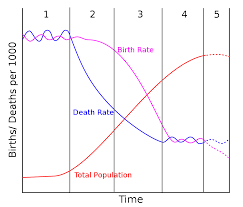The Demographic Transition Model is a framework used in demography and geography to understand changes in population growth rates as societies develop. This model identifies five stages of demographic transition and provides valuable insights into the patterns and dynamics of population change.

The demographic transition model was developed by American demographer Warren Thompson in 1929. However, the model has been further refined and developed by other demographers and researchers over time.
Table of Contents
Stages of Demographic Transition Model
There are five stages in the Demographic Transition Model.
Stage I
The first stage of demographic transition is characterized by a high birth rate and high death rate. In this stage, there is little population growth as the high death rates offset the high birth rates.
This is typically associated with pre-industrial societies that have high infant and child mortality rates and limited access to healthcare and sanitation. The population is often relatively small and stable, with little change in the number of births and deaths from year to year.
Stage II
In the second stage, death rates begin to decline due to improvements in healthcare and sanitation, while birth rates remain high. This leads to rapid population growth and is often referred to as the “population explosion.”
This stage is often associated with the early stages of industrialization, as improvements in technology and medicine lead to better living conditions and longer lifespans.
Stage III
In the third stage, birth rates begin to decline as a result of changes in social and economic conditions, such as increased access to education and greater opportunities for women. The death rate continues to decline, resulting in a slower population growth rate.
Stage IV
In the fourth stage of demographic transition, both birth and death rates are low, resulting in a slow rate of growth of the population. This stage is associated with developed, industrialized societies where access to education, healthcare, and family planning is widespread.
Stage V
The birth rates and death rates are equal, and this results in zero population growth. Western countries are currently in this stage.
Criticisms of the Demographic Transition Model
It has been criticized for its Eurocentric bias, as it was developed based on the experience of Western European countries. The model also assumes that changes in birth and death rates occur as a result of economic and social development, which may not always be the case.
Evaluation of the Demographic Transition Model
Despite its limitations, it remains an important framework for understanding the patterns and dynamics of population change. By identifying the stages of demographic transition, researchers can gain insight into the demographic changes that occur as societies develop. This can be useful for policymakers, demographers, and geographers working to understand the complex processes that shape our world.
Important Links
